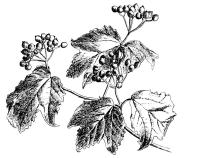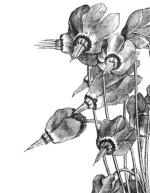|
|
Back to CUES Walkabout
CUES Walkabouta collaborative project with The Bell Museum of Natural History and The Minnesota Landscape Arboretum) |
|
Alternative Landscapes Tour at the Minnesota Landscape Arboretum |
 |
Welcome to our self guided tour of traditional landscaping alternatives.
The purpose of this tour is to highlight concepts applicable not only to
home gardeners but landscape professionals as well. These concepts include:
|
The Francis de Vos Home Demonstration Gardens consist of nine home gardens where traditional flower, fruit, and vegetable garden beds are used in new ways.
Two examples are the Garden for Small Spaces and the Herb/Kitchen Garden where yields are maximized in small spaces. Espaliered apples trained in a candelabra form grow against walls. These plants are pruned and trained to grow on a single plane, horizontally, diagonally or vertically. They're high maintenance yet practical for small spaces, very productive and highly decorative.
In the Fruit and Vegetables Garden, strawberries providing a groundcover at the base of the apples, thus two fruits grow in the same space. Look for further space saving ideas in the Patio and Container Garden's planters and hanging baskets. You'll see another space saving idea outside the garden, along the south side. Vegetables such as Swiss chard, tomatoes, and peppers grow together with the annual flowers mealycup sage, marigolds, and globe amaranth.
During the summer of 1996, Naturalistic Garden will be renovated. Many native wildflowers are featured, from the shade-tolerant, low-growing Dutchman's breeches (Dicentra cucullaria) and sharp-lobed hepatica (Hepatica acutiloba) to the tall, sun to part shade plants, boltonia (Boltonia asteroides) and Joe Pye weed (Eupatorium maculatum) Carefully selecting plants to match the available growing conditions results in less maintenance.
The Seisui-Tei Japanese Garden, across the path from the Home Demonstration Gardens, at first glance would seem high maintenance, yet some components, such as using woodchip mulch or groundcovers instead of grass, are low maintenance. Time spent pruning trees and shrubs in a Japanese garden may be less than the time spent mowing grass in a standard yard on an annual basis. Realize too, that there are no annuals in this garden. Color and texture are provided by perennials that normally would not need to be replaced annually.
 |
Under large sugarmaple trees is the Pauline Whitney MacMillan Hosta Glade, a National Display Garden of the American Hosta Society. This collection contains close to 300 different varieties of hosta and displays the variation in flower color, size and fragrance, as well as the different sizes, shapes and colors of the foliage. Hosta is one of the hardiest and easiest groundcovers for shady areas. |
 |
For color and variety, some shade tolerant flowers are interplanted. Spring flowering bulbs such as squill (Scilla sibirica), daffodils (Narcissus spp.) and snowdrops (Galanthus nivalis) appear before the hosta in spring and bask in the sun under still leafless trees. Coralbells (Heuchera sanguinea), bergenia (Bergenia cordifolia), and impatiens (Impatiens wallerania) add color and texture variations throughout the season. | |
 |
The Woodland Azalea Garden further exemplifies understory planting, or growing shade tolerant plants under trees. Azaleas grow poorly in clay soils , preferring acidic, well-drained soils, along a wooded area. Other plants that do well in the azalea garden include woody plants such as: star magnolia (Magnolia stellata), winterberry (Ilex verticillata), and viburnum (Viburnum dentatum and V. trilobum). | |
 |
Herbaceous understory plantings include: bloodroot (Sanguinaria canadensis), narcissus (Narcissus spp.), cranesbill geranium (Geranium spp.), astilbe (Astilbe spp., ligularia (Ligularia spp.), paxistima (Paxistima canbyii), goat's beard (Aruncus dioicus), martagon lilies (Lilium martagon), shooting star (Dodecatheon meadia) and rogersia (Rogersia aesculifolia). | |
| The new Clotilde Irvine Sensory Garden contains five sections. Idea Garden highlights accessible and alternative gardening through paved walkways, containers and raised beds. The plants used in this garden will be changed annually. The Sensory Walkway invites you to close your eyes and inhale the fragrance of the various plants. Plants used have been selected for trailing form, fragrance and texture. The Garden for Wildlife includes a self pruning hedge caged in chicken wire that lets the deer nibble only the new growth. Plants favored by deer, birds and insects are featured here. |  |
One more alternative garden you can tour is the Bennett/Johnson Prairie on Three Mile Drive. The prairie is burned one year and mowed the next to recycle nutrients. Unwanted woody vegetation is removed by hand. Some of the summer stars of this garden are: gray-headed coneflower (Ratibida pinnata) , butterfly weed (Asclepias tuberosa), rattlesnake master (Eryngium yuccifolium) and prairie blazing star (Liatris pycnostachya). In fall, the wild asters (Aster spp.), goldenrods (Solidago spp.), bottle gentian (Gentiana andrewsii) and sneezeweed (Helenium autumnale) almost steal the show from the showy seed heads of the prairie grasses in all their glory.
We hope this tour has given you some ideas that you can successfully incorporate into your home landscape. Remember to select appropriate plant material to match site conditions and to minimize fertilizer and pesticide requirements. There are many possibilities for developing alternative landscapes.
Copies of these publications are on display in the Andersen Horticultural Library together with order forms. You can also place a telephone order by calling Distribution at (612) 624-4900 or 1 (800) 876-8636.
Center for Urban Ecology and Sustainability and University of Minnesota Extension Service
Back to CUES Walkabout
 |
(C) Regents of the University of
Minnesota. All rights reserved. |
 |
 |